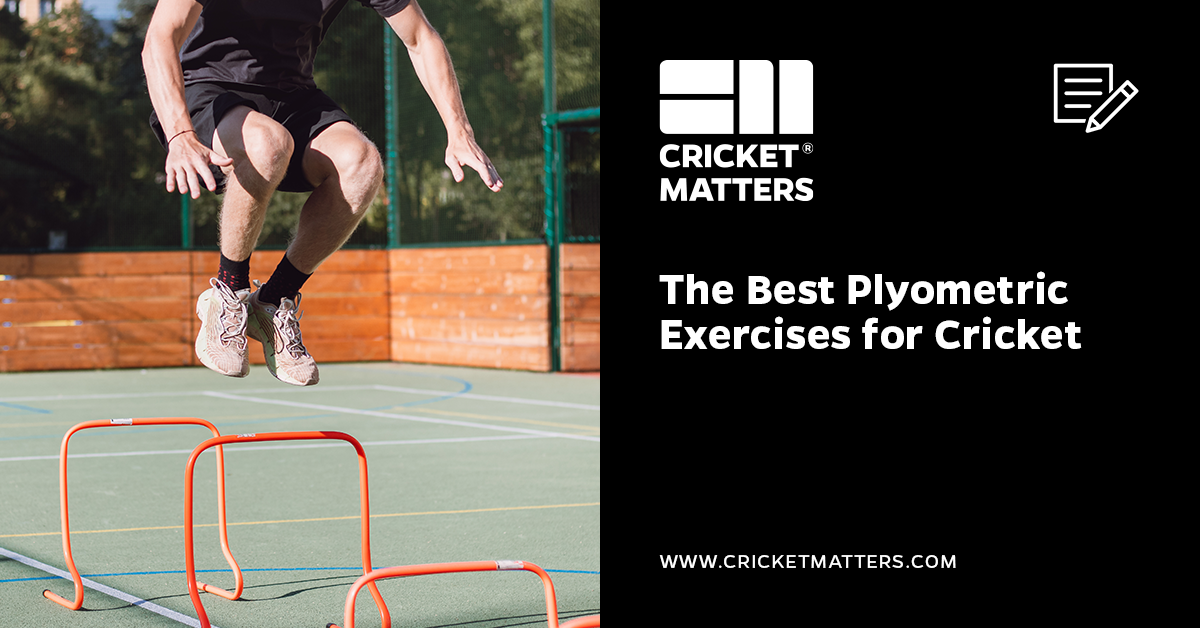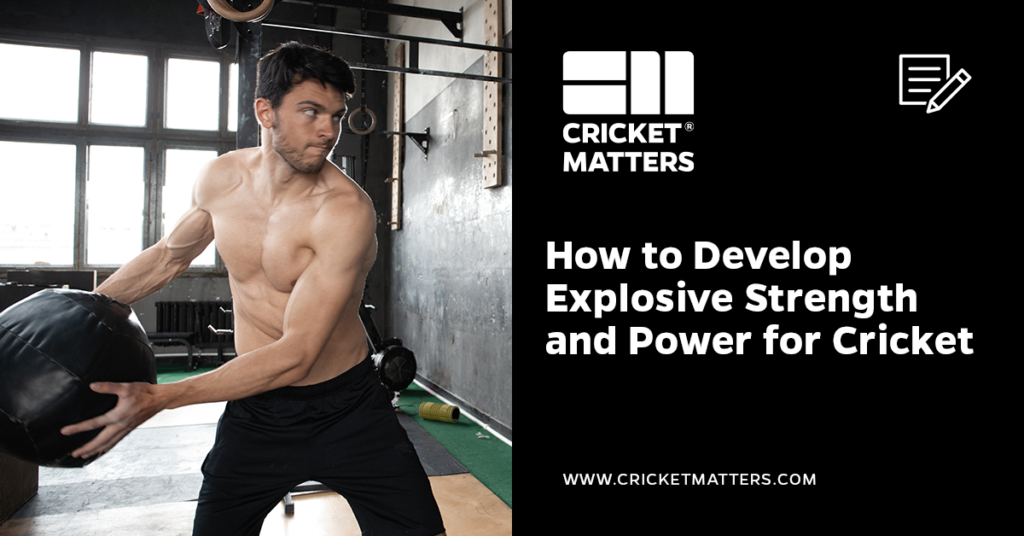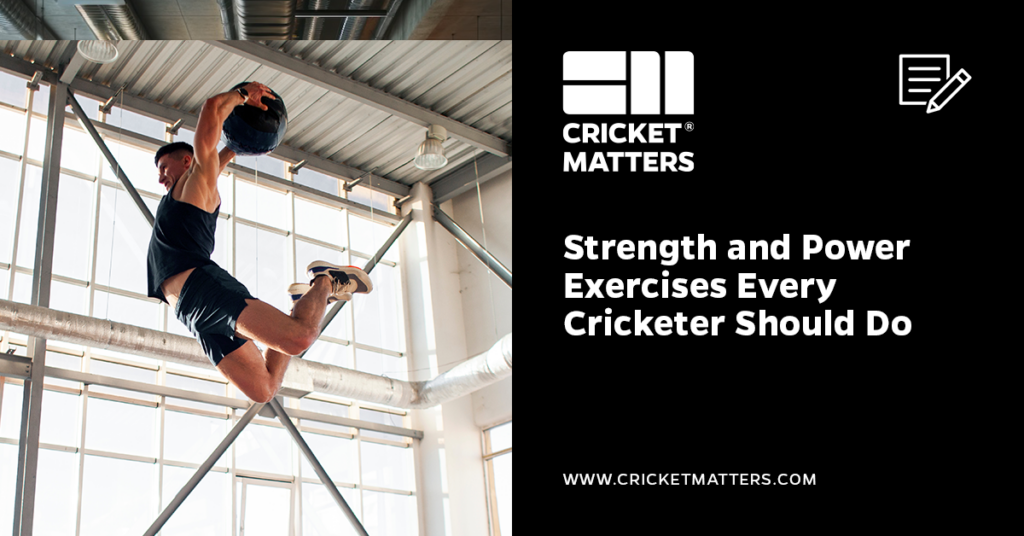
I hope you enjoy reading this blog post.
James Breese, Cricket Matters FounderIf you need my help with cricket coaching, strength and conditioning, injury rehab, or nutrition, click here.
In this post, I will show you 24 essential plyometric exercises for cricket we use with our athletes.
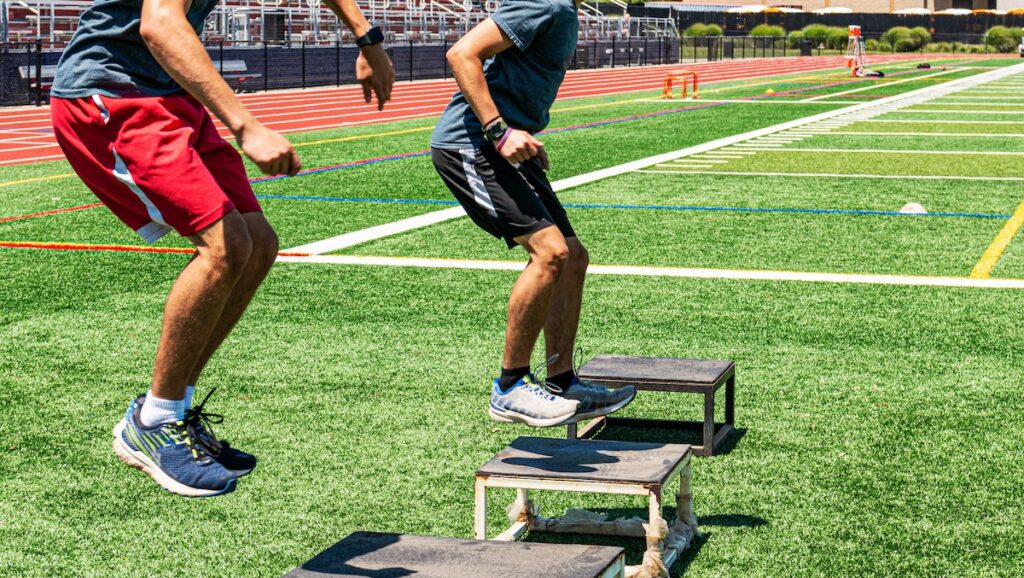
All these exercises are tried, tested, and timeless and are working fantastically for our athletes right now; however, make sure you choose the ones suitable for your level of training.
With that, here are our 24 essential plyometric exercises for cricket:
Table of Contents
[Beginner] Plyometric Exercises for Cricket
1. Box Jumps
Description: Box jumps are a foundational plyometric exercise where athletes propel themselves from the ground onto an elevated surface, such as a box or platform.
The exercise focuses on generating a powerful lower body contraction and is instrumental in developing explosive strength.
The key is selecting a box of appropriate height that challenges you without compromising form or safety.
How to Perform:
- Select a stable box with a height that allows you to land softly. This will enable you to land quietly and maintain a knee bend similar to your take-off position upon landing.
- Stand facing the box with your feet hip-width apart. Keep your knees and hips slightly bent, poised for the jump.
- Initiate a countermovement by swinging your arms, pushing your hips backwards, and loading the legs.
- Explosively jump upwards by driving through the balls of your feet. As you jump, swing your arms forward to add momentum.
- Bend your knees and hips as you land on the box to absorb the impact. Your landing should be quiet, with your feet hip-width apart and in a solid athletic position.
- Stand up straight to complete the jump, then step down one foot at a time with control, resetting your stance for the next repetition.
Cricket-Specific Benefits: For cricketers, box jumps are particularly beneficial for developing the type of explosive power needed for quick starts and immediate stops, an essential aspect of fielding, bowling and batting.
Regular practice of box jumps can improve a player’s ability to sprint after a ball, leap for a catch, or sprint quickly between the wickets.
This exercise enhances muscle coordination and force production.
2. Single Leg Box Hop
Description: The Single-Leg Box Hop is a variation of the traditional box jump designed to build unilateral strength and explosive power.
Focusing on one leg at a time helps correct imbalances and enhances the ability to generate force independently with each leg, which is crucial in many athletic movements, including cricket.
How to Perform:
- Choose a low-height box or a mini hurdle to build confidence, especially if you’re new to the exercise.
- Stand facing the box on one leg, ensuring the other is slightly bent at the knee and raised off the ground.
- Bend the knee of your standing leg slightly to prepare for the hop.
- Swing your arms and push through the ball of your foot to hop onto the box.
- Land softly and firmly on the same leg, absorbing the impact with your knee and hip slightly bent.
- Stand up straight to complete the hop, maintaining balance on the single leg.
- Step back down carefully, switching legs, and repeat the exercise.
Cricket-Specific Benefits: For cricketers, Single Leg Box Hops are invaluable for enhancing balance and stability through the ankles, knees, and hips, all of which contribute to efficiency and safety during play.
This exercise can improve a player’s running mechanics by strengthening each leg’s capacity for forceful push-offs and controlled landing.
The enhanced power in each leg can improve performance in bowling, batting, and fielding—especially in situations requiring weight transfer and balance on one leg, such as when playing a stroke or making a one-handed catch.
3. Single Leg Lateral Box Hop
Description: The Single-Leg Lateral Box Hop is an advanced plyometric exercise that targets the muscles used for side-to-side movements.
Executed on one leg, it challenges the body’s power, balance, and agility.
Practising medial and lateral movements engages various stabilizer muscles in the leg, hip, and core, which is crucial for multi-directional agility in cricket.
How to Perform:
- Stand parallel to a box or raised platform, balancing on the leg closest to the box. Ensure the other leg is raised slightly off the floor.
- Bend your standing leg at the knee and prepare to hop laterally.
- Propel yourself sideways by pushing off the ground with enough force to clear the distance and height of the box.
- Land on the same leg on top of the box, maintaining control and balance. Your landing should be as soft as possible, with a bend in the knee to absorb the impact.
- Straighten your leg to stand up entirely on the box, then carefully step down and repeat the movement in the opposite direction.
- After completing the set, switch to the other leg and perform the hops in medial and lateral directions to ensure balanced muscle development.
Cricket-Specific Benefits: The Single Leg Lateral Box Hop mainly benefits cricketers by enhancing the explosive power needed for lateral movements on the field.
This exercise can significantly improve a cricketer’s ability to make rapid directional changes, such as when chasing the ball, changing direction, running between wickets, or moving into position for a catch.
By strengthening the leg in medial and lateral directions, cricketers can achieve better stability, balance, and reactivity, all essential for high-level performance during a match.
4. Heiden & Stick (Skater Jumps)
Description: The Heiden & Stick, commonly known as Skater Jumps, is a plyometric exercise that mimics the lateral movements of a speed skater. This dynamic exercise emphasizes side-to-side jumping and landing on one leg, which builds lateral power, balance, and agility.
How to Perform:
- Starting Position: Begin in a slight squat position on one leg, with the other behind you, slightly off the ground for balance.
- Execution: Explosively jump to the side, landing on the opposite foot. As you land, control your motion by bending the knee and sticking the landing, ensuring stability and balance before the next jump.
- Sticking the Landing: Momentarily hold the landing position to enhance control and stability training. Focus on maintaining a good posture with your chest up and shoulders back.
- Repetition: Push off from the landed foot and repeat the movement to the other side. Continue alternating sides for the desired number of repetitions.
Specific Benefits for Cricket:
- Agility and Balance: These jumps improve agility and balance, which is crucial for cricket players who need to make quick lateral movements during a game, such as fielding or changing direction when running or sprinting.
- Lateral Power Development: This enhances the ability to generate power from side-to-side movements, which is beneficial for explosive power hitting when batting and dynamic fielding actions.
- Injury Prevention: Strengthens the muscles and joints involved in lateral movement, reducing the risk of injuries common in sports requiring sudden direction changes.
Incorporating Heiden & Stick exercises into a cricket training program can significantly improve a player’s lateral movement efficiency, making it a valuable addition to enhancing overall athletic performance on the field.
5. Hurdle Jump & Stick
Description: Hurdle Jump & Stick exercises introduce an additional challenge for cricketers by incorporating vertical leaps over hurdles.
This movement emphasizes the eccentric strength required for landing, as gravity becomes a more significant factor.
This plyometric exercise aims to develop a cricketer’s ability to handle the increased landing force after a higher jump, which is pivotal for dynamic movements when playing.
How to Perform Hurdle Jump & Stick:
- Set up a series of appropriate hurdles for your skill level—starting at a lower height, like 12 inches, and only increasing the height as your proficiency improves.
- Stand in front of the first hurdle with your feet shoulder-width apart and knees slightly bent.
- Propel yourself upward in a vertical leap, using your arms to gain extra height.
- Clear the hurdle, focusing on jumping both upward and slightly forward.
- Land softly on the balls of your feet on the other side of the hurdle, immediately bending your knees to absorb the impact. Aim to minimize noise on landing, which indicates a soft landing.
- Hold the landing position briefly to ensure stability and control before resetting or moving on to the next hurdle.
Cricket-Specific Benefits: For cricket players, mastering the Hurdle Jump & Stick is essential for developing the power and control needed in various aspects of the game.
It trains the muscles to cope with the high-impact forces experienced during fast-paced cricket play.
This includes explosive take-offs for quick singles, dynamic jumps for screamers of catches or rapid sprinting movements to stop a boundary.
Additionally, the controlled landing enforced by this exercise strengthens the joints and tendons, providing injury resilience during the sport’s sudden and intense movements.
6. Hurdle Hop & Stick
Description: The Hurdle Hop & Stick sharpens a cricketer’s single-leg explosive power and control.
This unilateral exercise enhances stability and coordination by requiring the athlete to jump over a hurdle and land on the same leg.
It’s a progression from the single-leg box hop, adding complexity by including an obstacle that must be navigated mid-air.
How to Perform Hurdle Hop & Stick:
- Place a hurdle at a manageable height before you; if you’re a beginner or working on stability, consider starting with a line on the floor or a very low obstacle.
- Balance on one leg with a slight bend in the knee, ready to jump.
- Propel yourself upward and forward, using a swinging motion of your arms to gain extra height and distance.
- Clear the hurdle, focusing on maintaining balance and control in the air.
- Land on the same leg, with the knee slightly bent to absorb the impact of the landing, mimicking the controlled eccentric phase of a box jump.
- Stick the landing, maintaining stability momentarily before stepping off to reset. Ensure the landing is as quiet as possible, which indicates a controlled and soft landing.
Cricket-Specific Benefits: The Hurdle Hop & Stick’s single-leg focus is invaluable for cricket players, who can mimic the single-leg landings and take-offs common during a match.
Whether sprinting for a quick single, leaping to avoid a run-out, bowling, or even lunging for a catch, this exercise improves the strength and proprioception needed during the game.
By enhancing eccentric control and unilateral power, cricketers can improve their in-game agility and reduce the risk of lower limb injuries.
7. 45 Degree Heiden & Stick
Description: The 45-degree Heiden & Stick is a variation of the traditional Heiden exercise, in which the athlete jumps and lands at a 45-degree angle.
This plyometric drill focuses on diagonal explosive movements, crucial for sports that require multidirectional agility and power, such as cricket.
How to Perform 45-Degree Heiden & Stick:
- Stand with your feet hip-width apart and knees slightly bent, facing forward.
- Push off from one leg, jumping diagonally at a 45-degree angle to the opposite side.
- Land on the opposite foot, bending the knee to absorb the impact while maintaining a low centre of gravity for balance and control.
- Stick the landing momentarily to ensure stability and control before returning to the starting position or continuing to alternate sides.
- As you grow more confident, increase the power and distance of your jump, always focusing on a controlled landing.
- Perform sets on both sides to maintain balance and symmetry in your muscle development.
Cricket-Specific Benefits: The 45-degree Heiden & Stick is particularly beneficial for cricketers, enhancing the ability to make explosive and agile movements in various directions on the field.
It improves a player’s capability to quickly change direction, which is valuable for making sudden shifts while fielding or adjusting footwork when batting.
This exercise also helps develop the stabilizing muscles around the ankle, knee, and hip joints, reducing the risk of injury during the rapid, angular movements often found in cricket.
8. Hurdle Jump & Bounce
Description: The Hurdle Jump & Bounce takes the basic hurdle jump to the next level by incorporating a reactive bounce immediately after landing.
This progression introduces an additional plyometric element, enhancing the athlete’s ability to quickly absorb and then reapply force, which is essential for many athletic movements in cricket.
How to Perform Hurdle Jump & Bounce:
- Position a series of hurdles at a height that allows you to clear them comfortably without compromising form.
- Stand in front of the first hurdle with your feet hip-width apart and knees slightly bent, ready for the jump.
- Leap over the hurdle, swinging your arms to help drive your body upward and forward.
- Upon landing softly with both feet, immediately perform a small bounce off the balls of your feet, preparing your muscles for the subsequent jump.
- Without any pause after the bounce, proceed to the next hurdle, continuing the pattern of jump-bounce-jump.
- Focus on maintaining a rhythmic pattern and consistent form throughout the series, keeping the bounces controlled and the jumps powerful and high.
Cricket-Specific Benefits: Adding the bounce element trains cricketers to handle better the repetitive and explosive movements required during play, such as repeated jumps for catching, quick hops, running between the wickets, or even for fast bowlers with their run-ups.
This exercise develops the power needed for an initial burst, allowing the muscles to recover and quickly prepare for subsequent efforts.
The continuous nature of the hurdle jump and bounce is excellent for improving a player’s explosive endurance, coordination, and timing—skills that can significantly impact performance during a cricket match.
9. Hurdle Hop & Bounce
Description: The Hurdle Hop and bounce is a challenging variation of the single-leg hurdle hop.
This exercise incorporates a dynamic bounce immediately after the landing, enhancing the ability to rebound quickly and prepare for the next explosive movement.
It requires balance, coordination, and unilateral strength, making it an advanced beginner plyometric drill.
How to Perform Hurdle Hop & Bounce:
- Set up a line of hurdles appropriate to your single-leg hopping ability—beginners may want to start with a single hurdle or a line on the floor.
- Balance on one leg in front of the hurdle, maintaining a slight bend in your knee, hips, and ankle, ready for the hop.
- Propel yourself forward and upward over the hurdle with an explosive single-leg hop.
- Upon landing on the same leg, immediately perform a small bounce, staying on the ball of your foot to ready yourself for the next hop.
- Continue the movement over subsequent hurdles or repeat the same hurdle if practising with one. The bounce should be quick and reactive, emphasizing the plyometric component.
- If you find the bounce too challenging, revert to the Hurdle Hop & Stick to build more strength and control before attempting the bounce again.
Cricket-Specific Benefits: The Hurdle Hop & Bounce is particularly beneficial for cricketers because it helps them develop quick, reactive movements often required during a game.
It helps improve balance and proprioceptive abilities on each leg, which is crucial for bowling, batting, and fielding.
This exercise also aids in building muscular endurance and stability in the lower limbs, enhancing a cricketer’s ability to perform repeated explosive movements throughout a match with reduced fatigue and risk of injury.
[Intermediate] Plyometric Exercises for Cricket
10. Pogo Jumps & Medial to Lateral Pogos
Description: Pogo Jumps are a form of plyometric exercise that primarily targets the lower body’s explosive power, utilizing a spring-like motion of the legs like jumping on a pogo stick.
Medial to Lateral Pogos add a directional change to the standard Pogo Jump, moving side-to-side, which increases the exercise’s complexity and demand on agility.
How to Perform:
- Pogo Jumps: Start by standing with your feet shoulder-width apart. Keep your knees slightly bent and arms by your sides. Propel yourself upwards using your ankles and calves, minimizing knee bend and maintaining a straight posture. Land softly and immediately jump again.
- Medial to Lateral Pogos: Begin in the same position as the Pogo Jumps. As you jump, shift your weight from one side to the other, moving laterally. Focus on quick, light touches of the feet on the ground and maintain a rhythmic motion from side to side.
Specific Benefits for Cricket:
- Enhanced Lower Body Power: Regular practice of these exercises increases the strength and explosive power of the calves and quads, which is crucial for quick sprints and agile movements on the field.
- Improved Agility and Balance: The lateral movements involved in Medial-to-Lateral Pogos are particularly beneficial for cricketers, as they mimic the side-to-side motion needed during fielding and batting.
- Increased Reactive Speed: These exercises help improve the speed of neuromuscular response, which is vital in situations that require quick changes of direction or sudden starts and stops, such as those in cricket gameplay.
Incorporating these pogos into a regular training routine can significantly enhance a cricketer’s performance by developing key athletic traits contributing to better agility, power, and overall field dynamics.
11. Single Leg Medial to Lateral Pogo Hops
Description: Single-leg Medial-to-Lateral Pogo Hops are an advanced variation of the traditional Pogo jump focusing on unilateral (single-leg) explosive power and lateral movement.
This exercise challenges balance, coordination, and the ability to control and generate force from one leg. It is beneficial for sports like cricket, where unilateral strength and agility are crucial.
How to Perform:
- Starting Position: Stand on one leg with the other foot off the ground. Keep your standing knee slightly bent to maintain balance.
- Execution: Push off with the standing leg to propel yourself upward and slightly to the side. Keep the jumps controlled and rhythmic, alternating the direction of the lateral movement with each jump.
- Landing: Aim for soft, controlled landings on the same leg, absorbing the impact through the ankle, knee, and hip. Maintain balance before the next jump.
- Repetition: Continue the movement for several repetitions before switching to the opposite leg.
Specific Benefits for Cricket:
- Enhanced Unilateral Strength: This strengthens each leg independently, improving power and stability, which is essential for cricket activities like bowling, batting, and sharp singles.
- Agility and Coordination: This activity develops agility and coordination by requiring the body to maintain balance and control while performing dynamic movements. This is crucial for fielding, especially when making quick directional changes to catch or field the ball.
- Injury Prevention: Strengthens the muscles and joints in each leg, reducing the risk of injuries commonly associated with asymmetrical sports movements, such as muscle imbalances and joint instability.
Single-leg Medial-to-Lateral Pogo Hops are an excellent way for cricketers to build sport-specific skills that translate directly into improved performance during matches.
They enhance their ability to execute quick, powerful, and coordinated movements under varied conditions on the cricket field.
12. 45-Degree Medial to Lateral Hops
Description: 45-degree Medial to Lateral Hops are dynamic plyometric exercises focusing on diagonal jumping patterns to improve multi-directional agility and explosive power.
By combining vertical and lateral movements, these hops are particularly beneficial for sports requiring quick, angular changes in direction.
How to Perform:
- Starting Position: Stand neutrally with feet hip-width apart. Engage your core and prepare to move dynamically.
- Execution: Propel yourself diagonally at a 45-degree angle to the left or right, using a single or alternating leg push-off, depending on your training focus. The movement should be explosive, driving off the balls of your feet.
- Landing: Aim for a controlled landing on the balls of your feet, maintaining balance and immediately preparing for the subsequent jump. Keep your knees slightly bent to absorb the impact.
- Repetition: Continue hopping in a zigzag pattern, alternating directions with each jump for the desired number of repetitions or time.
Specific Benefits for Cricket:
- Improved Agility and Quickness: These hops enhance the ability to change direction quickly, which is crucial for fielding positions and making quick turns while running between wickets.
- Lower Body Strength: Builds strength and power in the legs, essential for explosive starts and stops, both in batting and fielding.
- Enhanced Coordination: Develops coordination and spatial awareness, helping cricketers adapt their movements to various in-game situations swiftly and efficiently.
This exercise not only boosts physical attributes but also sharpens mental agility, making cricketers more adept at reacting to the dynamic pace of the game.
13. Lateral Single-Leg Broad Jump
Description: The Lateral Single Leg Broad Jump is a challenging plyometric exercise that targets the development of unilateral explosive power and lateral movement.
By focusing on one leg at a time, this exercise enhances balance, coordination, and side-to-side agility, which are crucial for sports performance.
How to Perform:
- Starting Position: Stand on one leg, with the other slightly lifted off the ground for balance. Face forward, keeping your body aligned.
- Execution: Explosively jump to the side, pushing off strongly with the standing leg. Extend your body sideways in the air, aiming for distance and height.
- Landing: Land softly on the same leg you jumped from, absorbing the impact with a bent knee to maintain balance and protect the joints. Stabilize yourself before the next jump.
- Repetition: Perform several jumps on the same leg, then switch to the other. Focus on maintaining form and power with each jump.
Specific Benefits for Cricket:
- Enhanced Lateral Power: This exercise builds significant lateral power and strength, enabling cricketers to make quick, powerful sidesteps, which are essential during fielding to catch or stop the ball.
- Improved Balance and Coordination: As cricketers often find themselves in positions where they must balance on one leg, this exercise directly enhances the ability to maintain stability in dynamic situations.
- Injury Prevention: Strengthening the muscles and joints through unilateral training helps reduce the risk of injuries commonly associated with asymmetrical sports movements, such as strains or sprains during rapid directional changes.
Incorporating the Lateral Single Leg Broad Jump into training routines can significantly improve a cricketer’s performance by boosting their ability to move quickly and efficiently in lateral directions, vital for effective fielding and batting techniques.
14. Reactive Lateral Single Leg Broad Jump
Description: The Reactive Lateral Single Leg Broad Jump is an advanced plyometric drill that enhances explosive lateral power and reactive agility.
This exercise incorporates a quick, responsive change of direction after each jump, simulating the rapid pace and unpredictable movements typical in cricket.
How to Perform:
- Starting Position: Stand on one leg with your body slightly leaning toward the upcoming jump.
- Execution: Explosively jump to the side, pushing off your standing leg. As soon as you land, immediately jump back to the original position. This exercise emphasizes minimal ground contact time and maximum responsiveness.
- Landing: Land on the same leg, absorbing the impact through a controlled and balanced posture. Keep your body ready to react instantly and move again.
- Repetition: Continue the reactive jumps back and forth for several repetitions or times before switching legs. Focus on the speed and efficiency of each movement.
Specific Benefits for Cricket:
- Improved Reaction Time: This drill enhances the ability to respond quickly to dynamic play situations, which is crucial for fielding effectively or adjusting batting stance and position under pressure.
- Greater Lateral Movement Efficiency: This develops the muscles involved in side-to-side movements, which helps cricketers move more efficiently across the field. It is particularly useful for chasing down balls or making quick positional adjustments.
- Enhanced Neuromuscular Coordination: Trains the neuromuscular system to handle quick changes in movement direction, improving overall motor control and agility.
The Reactive Lateral Single Leg Broad Jump is particularly beneficial for cricketers looking to enhance their fielding agility and batting responsiveness, which are crucial for top-level match performance.
15. Broad Jump to Box Jump
Description: The Broad Jump to Box Jump combines two powerful plyometric movements to enhance explosive leg power and precision. This exercise begins with a horizontal jump (broad jump) followed immediately by a vertical leap onto a box, challenging the distance and height aspects of jumping.
How to Perform:
- Starting Position: Stand appropriately in front of a sturdy box or platform. Your feet should be shoulder-width apart.
- Broad Jump: From a standing position, perform a broad jump by squatting slightly, swinging your arms, and then explosively jumping forward as far as possible.
- Box Jump: Upon landing the broad jump, immediately perform a box jump by using the momentum to spring upwards onto the box. Use your arms to aid the upward motion.
- Landing: Land softly on the box with both feet firmly planted. Stand up entirely on the box before stepping down carefully to reset.
- Repetition: Repeat the sequence for several reps, focusing on fluid movement between the broad and box jumps.
Specific Benefits for Cricket:
- Enhanced Power and Agility: This exercise significantly improves lower body strength and agility, crucial for quick accelerations and jumping abilities in cricket.
- Improved Coordination: Transitioning from a horizontal to a vertical jump requires coordination and control, which are essential for fielding skills, especially when making catches or diving stops.
- Injury Prevention: Regular practice can help strengthen the muscles and joints involved in jumping, reducing the risk of common lower-body injuries in cricket.
By incorporating the Broad Jump to Box Jump into training routines, cricketers can develop greater explosive power and agility, improving their performance in batting and fielding situations.
16. Med Ball Box Jump
Description: The Med Ball Box Jump is an advanced plyometric exercise that integrates the use of a medicine ball to add weight and resistance, enhancing the challenge of the traditional box jump. This exercise targets explosive power, coordination, and upper-body engagement, making it an effective full-body workout.
How to Perform:
- Starting Position: Stand facing a sturdy box or platform while holding a medicine ball at chest level. Ensure the box is of a height that allows for safe landing.
- Execution: Begin by lowering into a squat position while keeping the medicine ball close to your chest. Explosively jump up from the squat, driving through your legs and pushing the medicine ball upwards as you jump.
- Box Landing: Aim to land on the box with your feet flat and knees slightly bent to absorb the impact. As you land, pull the medicine ball back towards your chest.
- Step Down: Carefully step down from the box to return to the starting position and prepare for the next repetition.
- Repetition: Repeat the exercise for the desired repetitions, maintaining form and control throughout each jump.
Specific Benefits for Cricket:
- Enhanced Explosive Power: By adding the weight of the medicine ball, this exercise significantly increases the lower body power, which is crucial for quick bursts of speed and powerful, explosive jumps in cricket.
- Upper Body Strength: Pushing the medicine ball enhances upper body strength, particularly in the shoulders, arms, and chest, which is beneficial for throwing and bowling.
- Improved Coordination and Stability: Coordinating the jump with the medicine ball is a complex movement that promotes better overall body coordination and stability, essential for maintaining balance during dynamic cricket movements.
Incorporating the Med Ball Box Jump into a cricketer’s training program can improve physical power and functional movement, which is essential for optimal performance.
17. Heidens (Skater Jumps)
Description: Heidens, also known as Skater Jumps, are dynamic plyometric exercises focusing on lateral movement and explosive leg power. This exercise is beneficial for sports requiring quick side-to-side agility and strength, as it simulates the motion of a speed skater.
How to Perform:
- Starting Position: Stand with your weight on one leg, with the other slightly behind you for balance.
- Execution: Explosively jump to the side, landing on the opposite foot. Your trailing leg should swing behind your body to help drive the movement and maintain balance.
- Landing: Land softly on your foot, bending the knee to absorb the impact while maintaining balance and stability. Keep your torso upright and engaged.
- Repetition: Immediately push off with the landed foot, jumping back to the other side. Continue this side-to-side movement for the desired number of repetitions.
Specific Benefits for Cricket:
- Enhanced Lateral Agility: This exercise improves agility and quick directional changes, which are essential for fielding, especially in positions requiring quick foot movements to catch or stop the ball.
- Increased Leg Power: Builds explosive power in the legs, which is crucial for quick bursts of speed while batting or running between the wickets.
- Balance and Coordination: Improves balance and coordination, reducing the risk of falls and injuries during the game, which is vital for maintaining effective fielding and batting stances under pressure.
Regularly incorporating Heidens into a cricket training programme can significantly boost a player’s on-field performance by enhancing their ability to execute rapid, agile movements, which are vital to performance.
[Advanced] Plyometric Exercises for Cricket
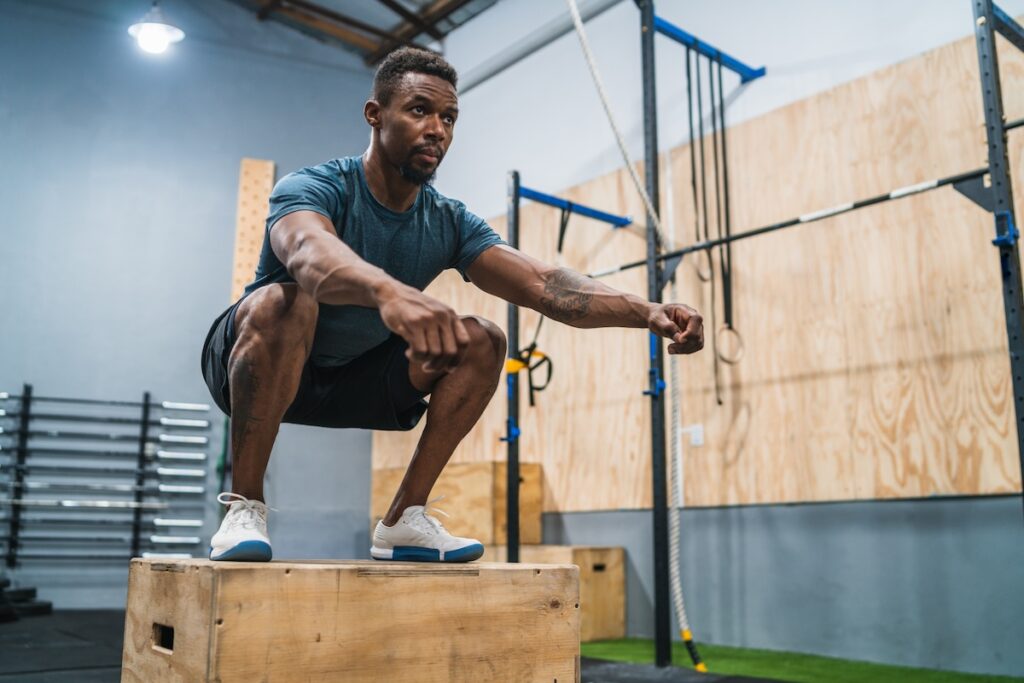
18. Band Resisted Heidens
Description: Band Resisted Heidens take the traditional Heiden exercise to the next level by adding lateral resistance, significantly increasing the demand on the working muscles.
This exercise targets the athlete’s ability to generate side-to-side explosive power. At the same time, the resistance band challenges their stability and strength, offering unique benefits to cricket’s dynamic nature.
How to Perform:
- Secure a resistance band around your waist and anchor it to a stable point on the side of your body.
- Assume an athletic stance, with feet shoulder-width apart and knees slightly bent.
- Explosively push off with the leg closest to the anchor point, leaping sideways.
- Land on the opposite leg, absorb the landing force, and stabilize your body, resisting the band’s pull.
- Return to the starting position and repeat for the desired reps before switching sides.
Cricket-Specific Benefits: Band-resisted Heidens are particularly beneficial for cricketers as they simulate the explosive lateral movements required in the game.
The resistance element trains the body to overcome external forces, enhancing a player’s ability to change direction and power quickly.
This exercise helps improve kinetic chain engagement and muscle synchronization, crucial for efficient and powerful movements.
19. Continuous Hurdle Jumps
Description: Continuous Hurdle Jumps are an advanced plyometric drill designed to improve explosive lower body power and endurance.
This repetitive, high-intensity exercise challenges an athlete to maintain a quick pace over each hurdle, focusing on both the vertical leap and forward momentum.
How to Perform:
- Set up a series of hurdles at a uniform height, allowing for a consistent jump pattern.
- Start at one end with a stance just wider than hip-width.
- Explode upward and forward, clearing the first hurdle with both feet.
- Immediately spring up again upon landing, minimizing ground contact time, and proceed to the next hurdle.
- Continue this pattern over each hurdle, maintaining a steady rhythm and form.
Cricket-Specific Benefits: Continuous Hurdle Jumps are ideal for cricketers to develop the repetitive power essential during match scenarios.
The exercise enhances a player’s elasticity, aerobic capacity and muscle resilience, enabling sustained performance under the high physical demands of a competitive match.
20. Continuous Hurdle Hops
Description: Continuous Hurdle Hops focuses on unilateral (single-leg) power and endurance, requiring athletes to hop over a series of hurdles on one leg.
This exercise emphasizes balance, coordination, and agility, pushing athletes to maintain control and speed with each hop.
How to Perform:
- Set up a row of low-height hurdles you can comfortably hop over on one leg.
- Begin on one leg, hop over the first hurdle, and land on the same leg.
- Continue hopping over each hurdle in succession without pausing between jumps.
- Maintain a steady pace, focusing on smooth landings and immediate launches.
- Complete the set on one leg before switching to the other, ensuring equal training.
Cricket-Specific Benefits: Continuous Hurdle Hops are excellent for cricketers who need to develop single-leg strength and stability, which are crucial for bowling and quick lateral movements in fielding.
This exercise improves proprioception and dynamic balance, enhancing a cricketer’s ability to perform under varied and unpredictable field conditions.
21. Lateral Hop to Broad Jump
Description: The Lateral Hop to Broad Jump combines lateral and linear plyometric movements to enhance multi-directional explosiveness. This exercise challenges athletes to execute a lateral hop immediately followed by a forward broad jump, integrating dynamic balance with powerful take-offs.
How to Perform:
- Start by standing on one leg at the side of your space.
- Perform a lateral hop to the opposite leg, landing softly and stabilizing yourself.
- Immediately from this lateral landing, execute a broad jump forward, driving with both legs to maximize distance.
- Land softly in a controlled squat position to absorb the impact.
- Reset and repeat the sequence, alternating the starting leg of each set for balance.
Cricket-Specific Benefits: This exercise is highly beneficial for cricketers as it simulates the quick, multi-directional movements required.
Enhancing the ability to change directions quickly and immediately sprint or jump helps improve fielding capabilities and batting, where quick lateral movements and rapid advancements are crucial.
22. Dumbbell Suitcase Jumps
Description: Dumbbell Suitcase Jumps are an advanced plyometric exercise incorporating additional weight to increase the intensity of the traditional vertical jump.
Holding a light dumbbell in each hand, similar to carrying suitcases, adds resistance, enhancing strength and power development.
How to Perform:
- Stand with your feet shoulder-width apart, each hand holding a dumbbell at your sides.
- Perform a standard squat to prepare for the jump, keeping your back straight and chest up.
- Explode upwards into a jump, driving through your heels and swinging the arms slightly for momentum.
- Land softly with knees bent to absorb the impact and immediately prepare for the next repetition.
- Keep the dumbbells close to your body throughout the exercise to maintain balance and control.
Cricket-Specific Benefits: For cricketers, Dumbbell Suitcase Jumps are excellent for building explosive power that translates directly to better performance on the field.
This includes more powerful running and jumping, faster bowling, and more powerful shots for batsmen.
The added weight of the dumbbells also helps improve overall muscle endurance, which is crucial during long matches.
23. Reactive Depth Jump
Description: Reactive Depth Jumps are designed to enhance explosive leg power and reactive strength by utilizing muscles’ and tendons’ natural elastic properties.
This exercise involves jumping down from a platform followed immediately by a high jump after landing.
Execution:
- Stand on a raised platform about 30 to 60 cm high.
- Step off the platform to land on both feet, keeping the knees slightly bent to absorb the impact.
- Immediately after landing, jump as high as possible, using your arms to gain additional height.
- Land softly, reset and repeat for the recommended number of repetitions.
Cricket-Specific Benefits: Reactive Depth Jumps are particularly beneficial for cricketers in improving their start speed and agility on the field.
The quick transition from absorbing the shock to launching a high jump helps develop fast-twitch muscle fibres, which are crucial for quick bursts of movement needed in fielding, bowling, and batting.
This exercise enhances overall coordination and balance, which is critical for any high-level cricketer.
24. Depth Jump to Broad Jump
Description: The Depth Jump to Broad Jump combines vertical and horizontal plyometrics into a single fluid movement to enhance multi-directional explosiveness.
This exercise starts with a depth jump from a platform, followed by a broad jump upon landing.
Execution:
- Stand on a platform approximately 30 to 60 cm high.
- Step off the platform and land with both feet, bending your knees to absorb the impact.
- Immediately jump forward without pausing, driving forward with your arms and legs.
- Land softly in a controlled squat position, absorbing the impact with your legs.
- Reset and prepare for the next repetition.
Cricket-Specific Benefits: Depth Jump to Broad Jump is particularly useful for cricketers looking to improve their dynamic fielding and running abilities.
This exercise enhances the ability to quickly transition from a high-impact landing to an explosive horizontal movement, mirroring the rapid changes in direction and pace required during a cricket match.
Implementing Plyometrics in Cricket Training
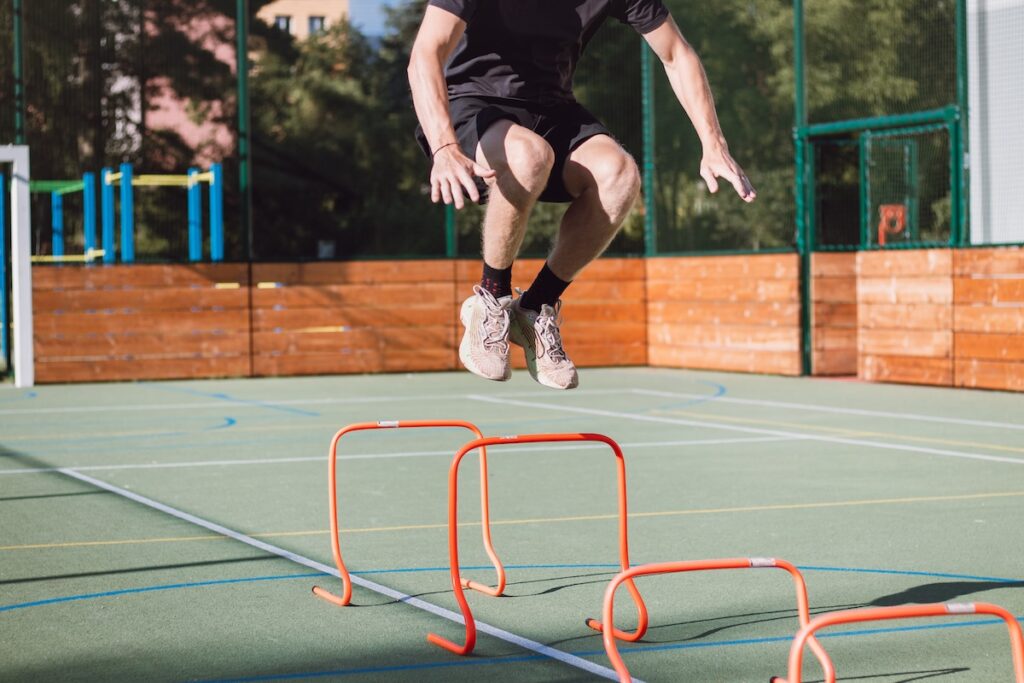
Creating a Plyometric Workout Plan for Cricketers
Cricketers need tailored, progressive training plans. Plyometrics, on their own, are just random acts of variety. It’s a party piece.
A plyometric workout schedule can be strategically designed to enhance performance while minimizing the risk of injury.
Here’s how we might put one together.
Weekly Plyometric Training Plan:
- Day 1: Lower Body Focus
- Warm-up with dynamic stretches and light cardio
- Pogo Jumps: 3 sets of 15 reps
- Broad Jump to Box Jump: 3 sets of 8 reps
- Heidens: 3 sets of 10 reps on each side
- Day 3: Upper Body and Core Focus
- Warm-up with dynamic upper body movements and core activation exercises
- Med Ball Throws (various directions): 3 sets of 10 reps
- Plyometric Push-Ups: 3 sets of 8 reps
- Medicine Ball Slams: 3 sets of 10 reps
- Day 5: Integrated Full Body Movements
- Warm up thoroughly with agility ladder drills.
- Lateral Single Leg Broad Jumps: 3 sets of 8 reps on each leg
- Reactive Lateral Single Leg Broad Jumps: 3 sets of 6 reps on each leg
- Skater Jumps: 3 sets of 10 reps in each direction.
Rest and Recovery: Ensure ample recovery between plyometric sessions. High-intensity workouts like these require adequate muscle recovery to prevent overtraining and injuries.
Active recovery days might include light jogging, yoga, or mobility work.
Final Thoughts: Plyometric Exercises for Cricket
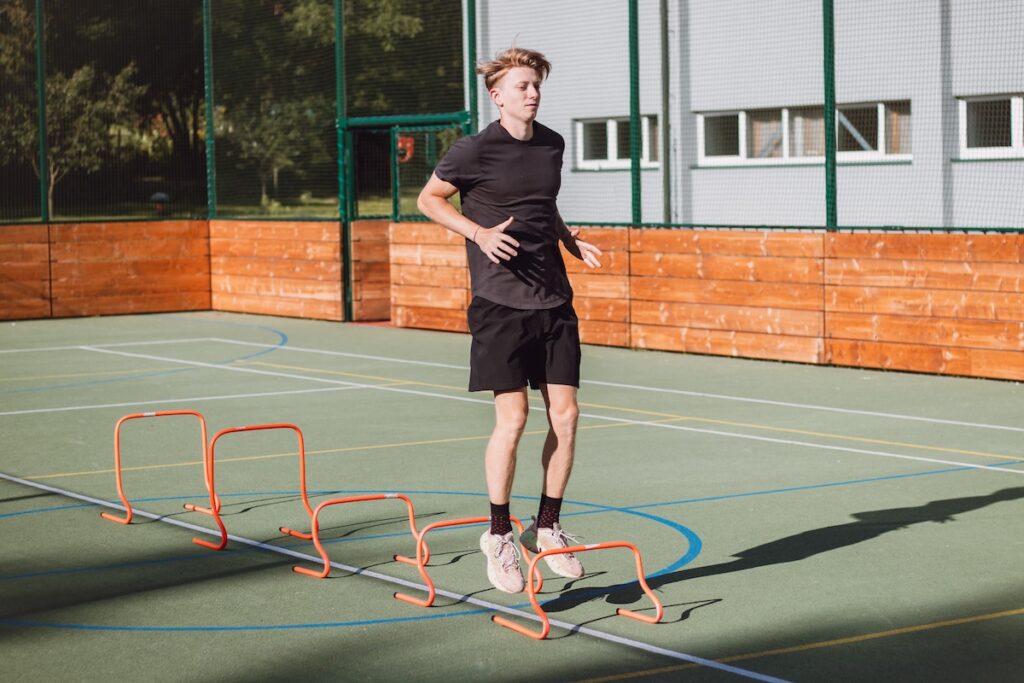
Plyometrics should be a fundamental part of all strength and conditioning programs for cricket.
Its integration offers myriad benefits, such as increased explosive power, agility, and speed, which are crucial for cricketers.
The exercises we’ve discussed target these key areas, enhancing the ability to perform rapid, powerful movements essential in cricket.
These exercises enhance the lower body strength needed to sprint faster, become a more agile fielder, and improve explosiveness, which is essential for fast bowling and powerful hitting when batting.
Making plyometric training an integral part of your practice schedule is not just beneficial; it’s indispensable for cricketers serious about pushing their limits and sustaining their performance at the highest levels.
Further Reading
FAQs
What Are the Key Benefits of Plyometric Exercises for Cricket Players?
Plyometric exercises enhance explosive strength, agility, and speed, which are crucial for cricket. They improve muscular power, enabling cricketers to execute quick sprints, powerful throws, and dynamic batting swings. Regular plyometric training can also boost cardiovascular fitness and help prevent injury by strengthening the muscles and connective tissues involved in high-impact cricket activities.
How Frequently Should Cricketers Perform Plyometric Exercises to See Improvements in Their Game?
Cricketers should integrate plyometric exercises into their training routine 2-3 times weekly. This frequency allows adequate recovery between sessions while providing sufficient stimulus for the muscles and nervous system to adapt and improve. Balancing plyometric training with skill practice, strength training, and adequate rest is crucial to avoid overtraining and maximize performance gains.
Can Plyometric Training Improve Both Bowling Speed and Batting Power in Cricket?
Yes, plyometric training can significantly improve both bowling speed and batting power. Players can generate more force during bowling and hitting by enhancing the muscles’ ability to contract rapidly and powerfully. This results in faster bowling speeds and more forceful bat swings, contributing to better cricket performance.
What Are Some Effective Plyometric Exercises Specifically for Cricket Bowlers?
Practical plyometric exercises for cricket bowlers include single-leg hops, bounding, and lateral jumps. These exercises develop lower-body strength and stability, essential for the explosive movements required during bowling. Incorporating medicine ball throws can also improve upper body explosive strength, which is crucial for fast bowling.
Are There Plyometric Exercises That Are Particularly Beneficial for Cricket Batsmen?
For cricket batsmen, plyometric exercises focusing on rotational power and lower body strength are particularly beneficial. Exercises like rotational medicine ball throws and lateral box shuffles improve the explosive rotational movements used during batting. Jump squats and tuck jumps enhance leg power and stability, aiding in powerful batting stances and swift movements.

